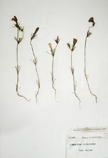History
|

|
by Maureen B. Sabit
There are only more than 200,000 plants that have been classified among the millions of plant species we have on Earth. The primary aim of systematics is to account for all the plant species present (especially those that are considered threatened or endangered) and to demonstrate the evolutionary relationships of these species. There are places that keep, preserve, maintain and act as centers for plant systematic research to safeguard collected plants of the distant past and the present. In our country, we have such "dwellings" and one of the oldest is the UST Herbarium.
 |
| Figure 3. Linantus dichotomous. Collected by Dr. Eduardo Quisumbing on March 1927 at California, USA. One of the herbarium's prized possesion. |
 |
| Figure 2. Thalaris canariensis (Poaceae). Collected by Emille Deyrolle in France. |
 |
Figure 1. Basella rubra (Basellaceae). One of the oldest plant collection (Dec. 31, 1929).
|
The UST Herbarium was once part of the UST Museum of Arts and Sciences and was established (1877) as part of the requirement of the Spaniards before UST could grant academic degrees in the sciences (Tresvalles A, Varsitarian). After World War II, the herbarium was placed under the supervision of the Faculty of Pharmacy and was relocated to Rms 212-213, in the second floor of the Main Building. New classrooms were then needed so the herbarium was again moved to the fourth floor of the same building, at the back of the store room department (Rodriguez L, Acta Manilana). In 1989, the herbarium was turned over to UST-RCNS and again relocated to the fourth floor of the UST Hospital Clinical Division. The herbarium is currently housed at Rm 301 of the Thomas Aquinas Research Center (TARC) and is provided with more space for the plant collections and its own laboratory for the processing of specimens.
Plant specimens collected from different provinces all over the country by undergraduate and graduate students (Figure 1) as well as resident researchers have greatly contributed to the bulk of the herbarium's collections. These include the thallophytes (algae, fungi, lichens), lower vascular plants (Clubmossess, horsetails and ferns), and higher vascular plants (Gymnosperms and Angiosperms). The oldest collections of the herbarium (1920's) were collected by former Pharmacy students taking up Systematic Botany and Pharmacognosy, as part of their effort to compile an inventory of medicinal plants (Tejada G, Varsitarian). Research expeditions in the 80's and 90's by the UST-RCNS Phytochemistry group also added to the collection which was gathered from Pangasinan, Mountain Province, Mindoro, Nueva Vizcaya, Isabela, Laguna, Quezon Province and Palawan (Tresvalles A, Varsitarian). At present, the herbarium holds more than 11,000 identified plant specimens. Part of the herbarium's collections was from Emille Deyrolle (Figure 2), a French naturalist, and; Dr. Eduardo Quisumbing (Figure 3), former Director of the National Museum and one of the pioneers of Philippine Plant Systematics. Quisumbing's collections include those taken from the Philippines and from the United States.
The herbarium is doing its best to preserve these collections by conducting an annual inventory. Some collections have been discarded because of the growth of molds and insects (mostly Lepisma saccharina or silverfish). Plans are underway to plot the different collections on the Philippine map to pinpoint where these specimens were collected, to place barcodes on the specimens for easy monitoring, and to improve the database.
References:
- Rodriguez, Lorenzo. "The UST Herbarium - New Source of Information for the Advancment of the Botanical Institute." Acta Manilana Series B, 2(14); Feb 1972
- Tresvalles, Anthony Noel. "UST Herbarium: Preserving a Heritage of Rich Flora." The Varsitarian, 16(12), p.7; Feb 4, 1995.
- Tejada, Gerald. "UST Herbarium: Botanical Treasure." The Varsitarian, 21(10), p.8; Feb 24, 2000.
|
|